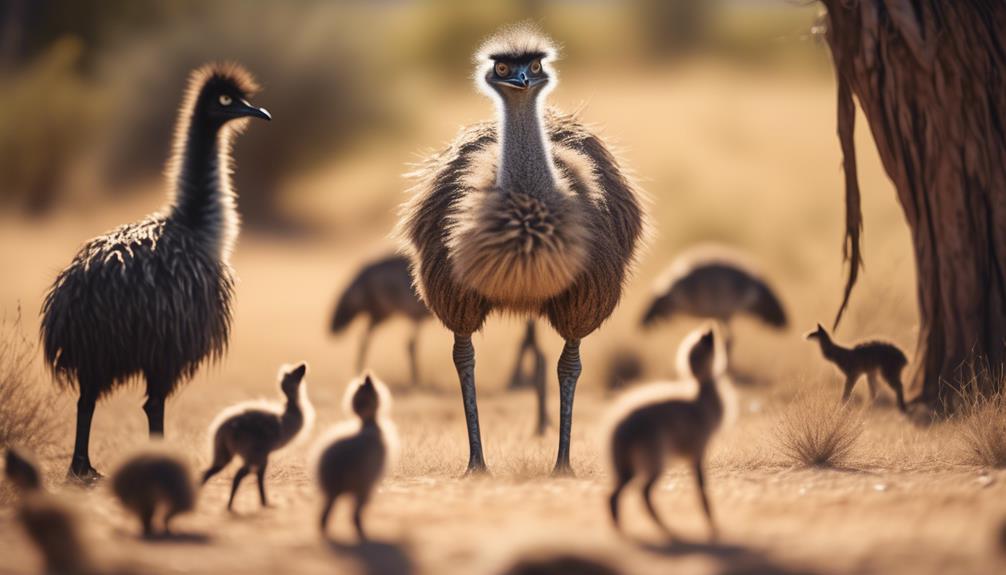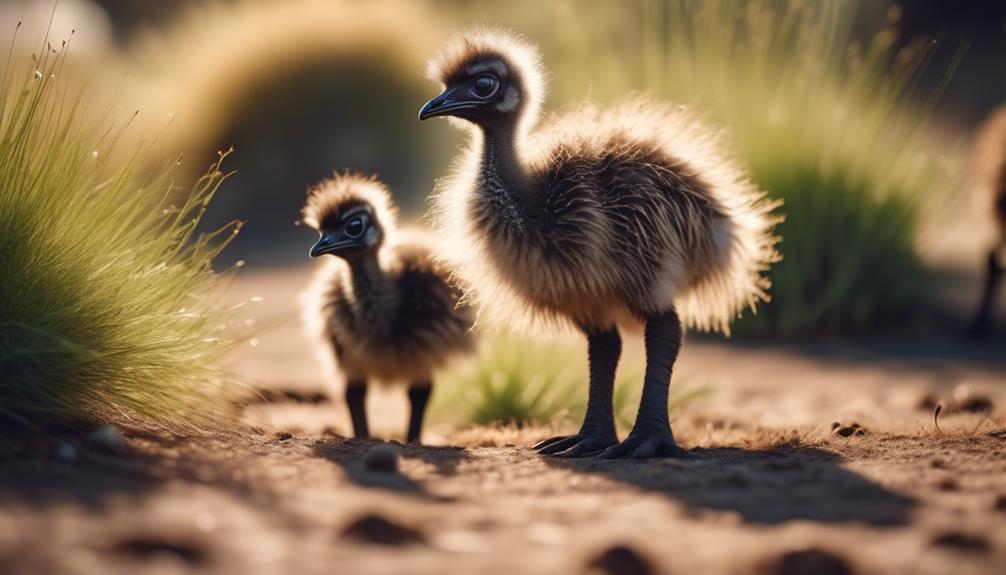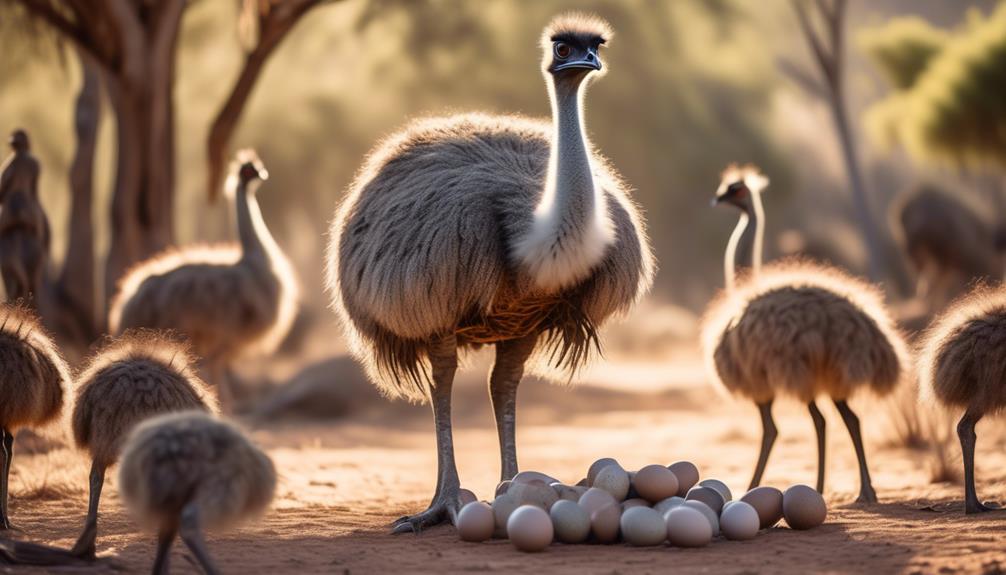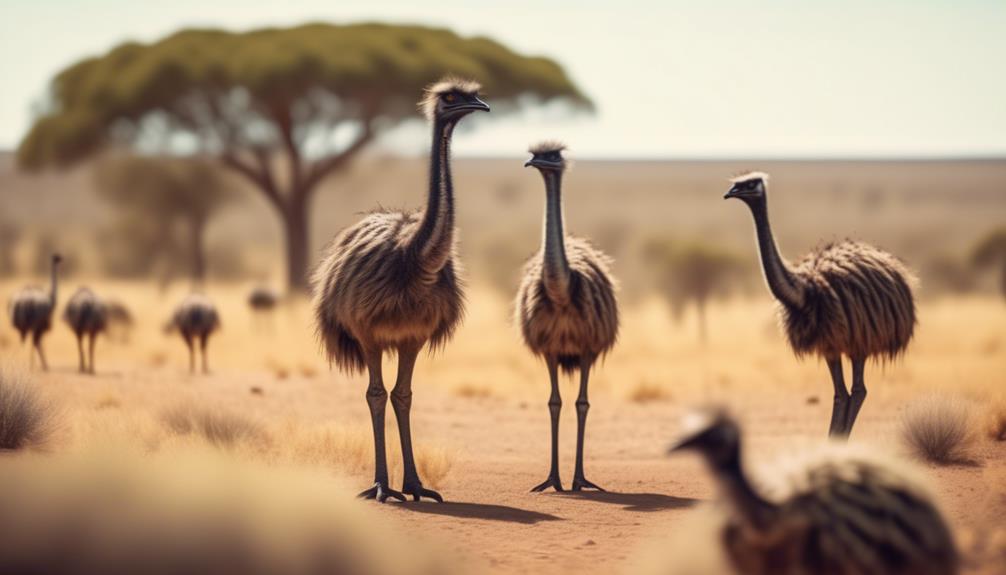
Did you know that the emu, a flightless bird native to Australia, plays a vital role in its ecosystem as both predator and prey? The intricate balance between emu predators and their prey is essential for maintaining the overall health and stability of the ecosystem.
From the cunning strategies employed by predators to the survival techniques developed by emu prey, there is much to explore and understand about this delicate relationship.
So, let's delve into the fascinating world of the emu ecosystem and discover how predators and prey coexist in a delicate dance for survival.
Key Takeaways
- Emu predators have significant ecological implications, including disruption of the food chain and alterations in emu foraging behavior.
- The decline of emu populations is linked to the presence of predators, impacting genetic diversity and overall health.
- Emus employ various survival strategies, such as camouflage, speed, group defense, and evasive maneuvers, to avoid predation.
- Conservation efforts should focus on habitat preservation, predator management, research and monitoring, public awareness and education, and collaborative efforts to protect emu populations and maintain a balanced ecosystem.
Emu Predators: A Threat to the Balance
Emu predators pose a significant threat to the delicate balance of the ecosystem, necessitating a comprehensive understanding of their impact on the population dynamics of these flightless birds. The emu population decline has been directly linked to the presence of these predators in their habitat. This decline has far-reaching ecological implications, as emus play a vital role in maintaining the balance of the ecosystem.
One of the key ecological implications of emu predators is the disruption of the food chain. Emus primarily feed on plant material, including leaves, grasses, fruits, and seeds. By consuming these plants, they help in seed dispersal and nutrient cycling. This, in turn, affects the overall vegetation structure and composition in their environment. However, with the presence of predators, emus may alter their foraging behavior and reduce their movement, leading to decreased seed dispersal and nutrient cycling. This can have cascading effects on the population dynamics of other species reliant on emu-dispersed seeds for their survival.
Furthermore, emu predators can also influence the behavior and distribution of emu populations. The fear of predation can cause emus to alter their habitat selection, resulting in changes in their spatial distribution. This can lead to localized declines in emu populations, which can negatively impact the genetic diversity and overall health of the species.
Understanding the ecological implications of emu predators is crucial for effective conservation strategies. By mitigating the threats posed by these predators, we can help stabilize emu populations and preserve the delicate balance of the ecosystem they inhabit.
The Adaptations of Emu Predators
Predators of the emu species exhibit a range of adaptations that enable them to effectively capture and consume these flightless birds. These adaptations have evolved over time to ensure their survival in the harsh Australian outback. Here are some of the remarkable adaptations and hunting techniques employed by emu predators:
- Speed and Agility: Predators such as dingoes and feral dogs rely on their exceptional speed and agility to chase down emus. With their powerful legs and streamlined bodies, they can easily keep up with their prey, closing in for a successful kill.
- Camouflage and Stealth: Large birds of prey like wedge-tailed eagles and falcons have developed excellent camouflage and stealth tactics. They blend seamlessly into their surroundings, allowing them to swoop down from above, catching emus off guard and striking with deadly precision.
- Cooperative Hunting: Some predators, like packs of dingoes, employ cooperative hunting techniques to increase their chances of success. By working together, they can effectively surround and overwhelm their emu prey, leaving them with no escape.
- Sharp Beaks and Claws: Predators such as monitor lizards and snakes have evolved sharp beaks and claws to efficiently capture and kill emus. These specialized appendages allow them to immobilize their prey quickly, preventing any chance of escape.
- Stealth and Patience: Predators like the elusive quolls and foxes rely on their stealth and patience to stalk and ambush emus. They patiently wait for the perfect moment to strike, ensuring a successful hunt.
These adaptations and hunting techniques showcase the incredible diversity and resourcefulness of emu predators, allowing them to thrive in their challenging environment.
Emu Predation Techniques Unveiled

Researchers have unveiled a comprehensive understanding of the various techniques employed by predators to successfully hunt emus in the Australian outback. Emu hunting techniques vary among different predators, with each species adapting its strategy to maximize success rates.
One common technique observed is the ambush method, where predators patiently wait in concealed locations, blending with the surroundings, and pouncing on unsuspecting emus as they pass by. This technique capitalizes on the element of surprise, allowing predators to swiftly immobilize their prey.
Another hunting technique commonly employed is the pursuit method. Predators with superior speed and agility, such as dingoes and feral dogs, engage in relentless chases, using their endurance and stamina to wear down the emus. By constantly applying pressure and exploiting the emu's vulnerability during exhaustion, these predators eventually overpower their prey.
Furthermore, some predators utilize cooperative hunting techniques to increase their chances of success. Packs of dingoes and feral dogs coordinate their efforts, strategically encircling emus and herding them towards an advantageous position. This collaborative approach enables the predators to isolate and overwhelm individual emus, ensuring a higher likelihood of capturing a meal.
Understanding these emu hunting techniques is crucial for comprehending emu predator population dynamics in the Australian outback. By gaining insight into the strategies employed by predators, researchers can better assess their impact on emu populations and work towards achieving a balanced ecosystem.
Emu Prey: Surviving the Hunt
To increase their chances of survival, emus have developed various strategies to evade predators in the Australian outback. These survival techniques have evolved over time, allowing emus to navigate the complex predator-prey dynamics of their environment. Here are some of the strategies that emus employ:
- Camouflage: Emus have adapted to blend in with their surroundings, making it harder for predators to spot them. Their brown feathers resemble the dry grasses and shrubs of the outback, offering them a crucial advantage in evading detection.
- Speed and Agility: Emus are incredibly fast runners, capable of reaching speeds up to 30 miles per hour. Their long legs and powerful muscles allow them to outrun many predators, making it difficult for them to be caught.
- Group Defense: Emus often travel in groups, known as mobs, which provide safety in numbers. When threatened, the mob will scatter in different directions, confusing the predator and making it harder to target a single emu.
- Vigilance: Emus have excellent eyesight and hearing, allowing them to detect predators from a distance. They stay alert and are quick to react, giving them a better chance of escaping.
- Evasive Maneuvers: Emus have a unique ability to change direction swiftly while running, using sudden turns, dodges, and zigzag movements to confuse and outmaneuver predators.
Emus have honed these survival techniques over generations, adapting to the challenges posed by their predators. Their ability to evade capture is a testament to their resilience and resourcefulness in the face of the harsh Australian outback.
Feeding Habits of Emu Prey

Emu prey, consisting of various plant matter and small invertebrates, make up the diet of these impressive flightless birds in the Australian outback. Emus are selective in their feeding behavior, adapting their prey selection to the availability of food sources in their habitat.
The primary component of an emu's diet is plant matter. They consume a variety of vegetation such as grasses, leaves, fruits, and seeds. Emus are opportunistic feeders, utilizing their sharp beaks to pluck and tear plant material. They're particularly fond of succulent plants, which provide essential water content during dry periods. This feeding behavior allows emus to efficiently gather nutrients from plants, ensuring their survival in a harsh environment.
In addition to plant matter, emus also consume small invertebrates. They've been observed eating insects, spiders, and even small reptiles. Emus use their beaks to peck at the ground or bushes, searching for hidden prey. This behavior is especially prominent during the breeding season when emus require a higher intake of protein. The consumption of invertebrates provides emus with essential nutrients, contributing to their overall health and vigor.
The feeding habits of emu prey are crucial for their survival. By adapting their prey selection to the availability of food sources, emus can maintain a balanced diet throughout the year. Understanding the intricate relationship between emus and their prey contributes to our knowledge of the delicate ecosystem in which these remarkable birds thrive.
Strategies for Evading Emu Predators
The intricate relationship between emus and their prey extends beyond feeding habits, as emu prey have developed various strategies for evading their predators. To survive in the challenging environment, these creatures have evolved remarkable avoidance techniques and camouflage strategies that allow them to remain hidden from the watchful eyes of emu predators.
- Cryptic Coloration: Many species of emu prey, such as rabbits and rodents, have adapted their fur or skin color to blend seamlessly with their surrounding environment. This cryptic coloration helps them evade detection by emus, as their predators struggle to distinguish them from the natural background.
- Freezing Behavior: When faced with imminent danger, some emu prey have developed an instinctual response to freeze in place. By remaining motionless, they minimize the chances of attracting the attention of their predators. This strategy works particularly well in open areas where movement is more easily noticed.
- Burrowing: Emu prey like ground-dwelling birds and small mammals have evolved the ability to dig burrows as a means of evading predators. These underground hideouts provide them with a safe refuge where they can escape from emus and other potential threats.
- Acrobatic Maneuvers: Agile and nimble, certain emu prey species have developed remarkable acrobatic skills. They can swiftly navigate through dense vegetation or leap across obstacles, making it difficult for emus to catch them.
- Mimicry: Some emu prey species have evolved to mimic the appearance or behavior of other organisms to confuse predators. By imitating a less desirable or dangerous species, they reduce their chances of being targeted by emus.
These avoidance techniques and camouflage strategies employed by emu prey showcase the remarkable adaptability and survival instincts of these animals. Through these mechanisms, they've managed to carve out a niche in the emu ecosystem, ensuring their own continued existence.
Reproduction and Emu Predation

Reproductive strategies in emu prey are influenced by the constant threat of predation. Emus, like many other prey species, have evolved various reproductive behaviors to increase their chances of survival in the face of predation pressure. One such behavior is the timing of reproduction. Emus typically mate during the cooler months, when the risk of predation is lower. This allows them to maximize their chances of successful reproduction while minimizing the risk to themselves and their offspring.
Another important reproductive behavior in emus is their choice of nesting sites. Emus tend to select nesting sites that provide good visibility and cover, which helps them detect and evade potential predators. They also build their nests in secluded areas, such as dense vegetation or tall grass, which offer protection from predators and reduce the chances of their nests being discovered.
The impact of predation on emu reproduction can be significant. High predation pressure can lead to decreased reproductive success, as predators may destroy nests or kill young emus. This can result in lower population growth rates and, in extreme cases, even population decline.
Impacts of Emu Predation on Ecosystem Dynamics
The presence and activity of emu predation within an ecosystem can have profound effects on its overall dynamics.
Emus, as predators, play a crucial role in maintaining the balance of the ecosystem by controlling the population of their prey species.
The impacts of emu predation on ecosystem balance and the ecological consequences are as follows:
- Population Regulation: Emu predation helps regulate the population of their prey species, preventing overpopulation and ensuring the availability of resources for other organisms. This promotes a healthier and more stable ecosystem.
- Species Interactions: Emu predation influences the interactions between different species within the ecosystem. It can affect the distribution and behavior of prey species, leading to changes in their feeding habits, reproduction, and even migration patterns.
- Biodiversity: By controlling the population of certain prey species, emu predation indirectly contributes to the maintenance of biodiversity within the ecosystem. This allows for a greater variety of species to coexist, creating a more resilient and adaptive ecosystem.
- Ecosystem Functioning: The ecological consequences of emu predation extend beyond population regulation. It can impact nutrient cycling, energy flow, and overall ecosystem functioning. For example, the grazing behavior of emus can influence vegetation growth, which in turn affects other organisms dependent on those plants.
- Community Dynamics: Emu predation influences the structure and dynamics of the entire community within the ecosystem. It can shape the composition of species, their abundance, and their interactions, ultimately determining the overall stability and resilience of the ecosystem.
Understanding the impacts of emu predation on ecosystem dynamics is essential for effective conservation and management strategies. By recognizing the intricate connections between predators and prey, we can strive towards maintaining a balanced and thriving ecosystem for future generations.
Human Interactions With Emu Predators and Prey

Human interactions with emu predators and prey play a significant role in shaping the dynamics of the ecosystem. The delicate balance between humans and wildlife, particularly emu predators and prey, is crucial for the overall health and sustainability of the ecosystem. However, this balance is often disrupted due to the occurrence of human-wildlife conflicts.
Human-wildlife conflict arises when the interests or actions of humans and wildlife clash, leading to negative consequences for both parties. In the case of emu predators and prey, such conflicts can have a profound impact on the predator-prey dynamics within the ecosystem. For instance, human activities such as habitat destruction and the introduction of invasive species can disrupt the natural habitat and food sources of emu predators, leading to a decline in their population. This, in turn, can have cascading effects on the abundance of emu prey species, as their predators play a crucial role in regulating their populations.
Furthermore, human interactions with emu predators and prey can also influence the behavior and distribution of these species. For example, the presence of humans in certain areas may deter emu predators from hunting, leading to an increase in the population of prey species. Conversely, human activities that encroach on the natural habitats of emu prey can result in their displacement or decline.
To address these human-wildlife conflicts and sustain the predator-prey dynamics, it's essential to implement effective management strategies. This may involve the establishment of protected areas, habitat restoration, and the development of conservation plans that consider the needs of both humans and wildlife. By striking a balance between human activities and the needs of emu predators and prey, we can ensure the long-term survival and well-being of these species and the overall health of the ecosystem they inhabit.
Conservation Efforts to Protect Emu Populations
Conservation efforts are crucial for protecting emu populations and ensuring their long-term survival. To address the challenges faced by emus in their predator-prey relationship, various conservation strategies have been implemented. These efforts aim to maintain a balance in the emu ecosystem and protect the species from decline.
- Habitat preservation: Protecting the natural habitat of emus is essential for their survival. This includes preserving their feeding areas, nesting sites, and migration routes. By conserving their habitat, emu populations can thrive and maintain healthy numbers.
- Predator management: Managing predators is another important aspect of emu conservation. Implementing measures to control or mitigate the impact of predators, such as dingoes or foxes, can help reduce predation on emus and increase their chances of survival.
- Research and monitoring: Conducting scientific research and monitoring emu populations allows conservationists to gather valuable data on their behavior, population size, and habitat requirements. This information helps in developing effective conservation strategies and adapting them as needed.
- Public awareness and education: Raising awareness among the public about the importance of emu conservation is crucial. Educating people about the predator-prey relationship and the role of emus in maintaining a balanced ecosystem can foster a sense of appreciation and support for their protection.
- Collaborative efforts: Conservation efforts require collaboration between government agencies, conservation organizations, and local communities. By working together, stakeholders can pool resources, expertise, and knowledge to implement comprehensive conservation plans that benefit emu populations.
Through these conservation strategies, we can help protect emus and ensure their continued existence in the wild. By understanding the predator-prey relationship and the importance of maintaining a healthy ecosystem, we can contribute to the long-term survival of these remarkable creatures.
Frequently Asked Questions
How Do Emu Predators Affect the Overall Balance of the Ecosystem?
Emu predators play a crucial role in maintaining the balance of the ecosystem. By controlling the emu population, they prevent overgrazing and ensure the survival of other species. Their presence has significant effects on the overall health and diversity of the ecosystem.
What Are Some Unique Adaptations of Emu Predators That Allow Them to Effectively Hunt Emus?
You'll never believe what emu predators are capable of! With their incredible adaptations like camouflage and lightning-fast speed, they've mastered the art of hunting emus. It's a survival of the fittest out there!
Are There Specific Hunting Techniques That Emu Predators Utilize to Catch Their Prey?
Emu predators employ various hunting techniques to capture their prey. These include stealthy stalking, sudden bursts of speed, and coordinated attacks. Conversely, emu prey have developed survival strategies such as vigilance, endurance, and group defense to evade being caught.
How Do Emu Prey Species Survive in an Environment With Such a High Predation Risk?
To survive in an environment with high predation risk, emu prey species have developed various survival strategies. These include adaptations such as camouflage, speed, agility, and alertness, as well as behaviors like group living and vigilance.
What Strategies Do Emu Prey Employ to Evade Capture by Emu Predators?
To evade emu predators, emu prey employ various strategies. Camouflage tactics, such as blending into the environment, help them stay hidden. Additionally, they use group defense strategies, sticking together to increase their chances of survival.
Conclusion
In conclusion, the delicate balance between emu predators and prey is crucial for the health and sustainability of the ecosystem. Emu predators, with their cunning techniques, challenge the adaptability of their prey.
However, the survival instincts of emu prey, coupled with their feeding habits and reproductive strategies, allow them to endure this relentless hunt.
Human interactions with emu predators and prey further influence the dynamics of this intricate system. Conservation efforts must be undertaken to protect these fascinating creatures and maintain the harmony of the emu ecosystem.


